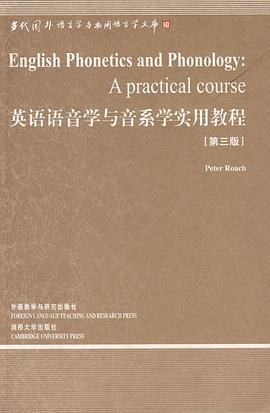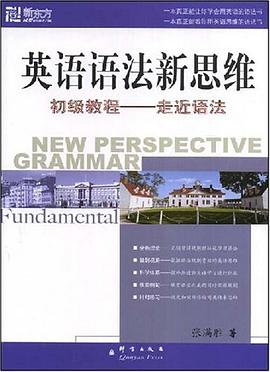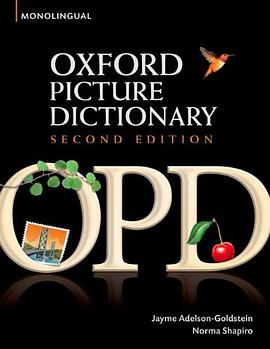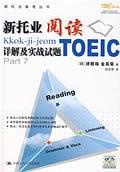

具体描述
《英语语音学与音系学实用教程(第3版)》主要内容:《英语语音学与音系学实用教程(第3版)》自出版以来一直是英国语音学与音系学领域内非常实用、全面的教科书,为世界各地的大学和研究机构所采用。
当代国外语言学与应用语言学文库
作者简介
目录信息
List of symbols
Chart of the International Phonetic Alphabet
How to use this book
1 Introduction
2 The production of speech sounds
2.1 Articulators above the larynx
2.2 Vowel and consonant
2.3 English short vowels
3 Long vowels, diphthongs and triphthongs
3.1 Long and short vowels
3.2 Diphthongs
3.3 Triphthongs
4 Voicing and consonants
4.1 The larynx
4.2 Respiration and voicing
4.3 Plosives
4.4 English plosives
4.5 Fortis and lenis
5 The phoneme
5.1 The phoneme
5.2 Symbols and transcription
5.3 Phonology
6 Fricatives and affricates
6.1 Production of fricatives and affricates
6.2 The fricatives of English
6.3 The affricates
6.4 Fortis consonants
7 Nasals and other consonants
7.1 Nasals
7.2 The consonant 1
7.3 The consonant r
7.4 The consonants j and w
8 The syllable
8.1 The nature of the syllable
8.2 The structure of the English syllable
8.3 Syllable division
8.4 Practical conclusions
9 Strong and weak syllables
9.1 Strong and weak
9.2 The e vowel ("schwa")
9.3 Close front and close back vowels
9.4 Syllabic consonants
10 Stress in simple words
10.1 The nature of stress
10.2 Levels of stress
10.3 Placement of stress within the word
11 Complex word stress
11.1 Complex words
11.2 Suffixes
11.3 Prefaxes
11.4 Compound words
11.5 Variable stress
11.6 Word-class pairs
12 Weak forms
13 Problems in phonemic analysis
13.1 Affricates
13.2 The English vowel system
13.3 Syllabic consonants
13.4 Clusters of s plus plosives
13.5 Schwa (e)
13.6 Distinctive features
13.7 Conclusion
14 Aspects of connected speech
14.1 Rhythm
14.2 Assimilation
14.3 Elision
14.4 Linking
15 Intonation 1
15.1 Form and function in intonation
15.2 Tone and tone languages
15.3 Complex tones and pitch height
15.4 Some functions of English tones
16 Intonation 2
16.1 The tone-unit
16.2 The structure of the tone-unit
16.3 Pitch possibilities in the simple tone-unit
17 Intonation 3
17.1 Fall-rise and rise-fall tones followed by a tail
17.2 High and low heads
17.3 Problems in analysing the form of intonation
17.4 Autosegmental treatment of intonation
18 Functions of intonation 1
18.1 The attitudinal function of intonation
19 Functions of intonation 2
19.1 The accentual function of intonation
19.2 The grammatical function of intonation
19.3 The discourse function of intonation
19.4 Conclusions
20 Further areas of study in phonetics and phonology
20.1 Laboratory phonetics
20.2 The study of variety
Recorded exercises
Unit 2: English short vowels
Unit 3: Long vowels, diphthongs and triphthongs
Unit 4: Plosives
Unit 5: Revision
Unit 6: Fricatives and affricates
Unit 7: Further consonants
Unit 8: Consonant clusters
Unit 9: Weak syllables
Unit 10: Word stress
Unit 11: Complex word stress
Unit 12: Weak forms
Unit 13: Revision
Unit 14: Elisions
Unit 15: Tones
Unit 16: The tone-unit
Unit 17: Intonation
Unit 18: Intonation: extracts from conversation
Unit 19: Transcription of connected speech
Unit 20: Further practice on connected speech
Answers to written exercises
Answers to recorded exercises
Recommendations for general reading
Bibliography
Index
· · · · · · (收起)
读后感
一,特点: 导读提醒我们:本书采用英国语音学派标调方法。这就与我们(即先接触美国结构主义、生成音系学的人)熟悉的一些标调方法不同。与此同时,本书也很少介绍生成派的其他东西,一方面是作为英语教材在简洁上的需要,另一方面也证实本书是英国语音学派的著作,跟生成派不...
评分一,特点: 导读提醒我们:本书采用英国语音学派标调方法。这就与我们(即先接触美国结构主义、生成音系学的人)熟悉的一些标调方法不同。与此同时,本书也很少介绍生成派的其他东西,一方面是作为英语教材在简洁上的需要,另一方面也证实本书是英国语音学派的著作,跟生成派不...
评分一,特点: 导读提醒我们:本书采用英国语音学派标调方法。这就与我们(即先接触美国结构主义、生成音系学的人)熟悉的一些标调方法不同。与此同时,本书也很少介绍生成派的其他东西,一方面是作为英语教材在简洁上的需要,另一方面也证实本书是英国语音学派的著作,跟生成派不...
评分一,特点: 导读提醒我们:本书采用英国语音学派标调方法。这就与我们(即先接触美国结构主义、生成音系学的人)熟悉的一些标调方法不同。与此同时,本书也很少介绍生成派的其他东西,一方面是作为英语教材在简洁上的需要,另一方面也证实本书是英国语音学派的著作,跟生成派不...
评分一,特点: 导读提醒我们:本书采用英国语音学派标调方法。这就与我们(即先接触美国结构主义、生成音系学的人)熟悉的一些标调方法不同。与此同时,本书也很少介绍生成派的其他东西,一方面是作为英语教材在简洁上的需要,另一方面也证实本书是英国语音学派的著作,跟生成派不...
用户评价
语音学教材。系统性还是有的,但总是有一种夹在实用和理论之间的尴尬感。Peter真的有点啰嗦,但是不讨厌。
评分简单明了,可知其然并知其所以然。
评分受益匪浅,但是最后面音系学的部分感觉都没有什么研究成果,一直说要做实验如何如何,感觉很多余
评分受益匪浅,但是最后面音系学的部分感觉都没有什么研究成果,一直说要做实验如何如何,感觉很多余
评分引进教材,不引进配套音频,脑子怎么想的?!
相关图书
本站所有内容均为互联网搜索引擎提供的公开搜索信息,本站不存储任何数据与内容,任何内容与数据均与本站无关,如有需要请联系相关搜索引擎包括但不限于百度,google,bing,sogou 等
© 2025 book.wenda123.org All Rights Reserved. 图书目录大全 版权所有




















